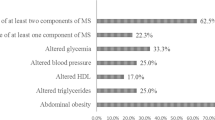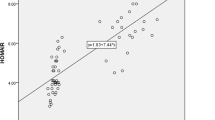Abstract
Background
Abdominal obesity is associated with high plasma triglyceride and with low plasma high-density lipoprotein cholesterol levels.
Aim and methods
Objective of the study was to find an association between plasma lipid and lipoprotein levels and anthropometric parameters in abdominal obesity in Slovakian university students. Lipid profile and anthropometric parameters of obesity were studied in a sample of 419 probands, including 137 men and 282 women.
Results
Males had higher values of non-high-density lipoprotein cholesterol (non-HDL-C), low-density lipoprotein cholesterol (LDL-C), triglycerides (TG) and very low-density lipoprotein cholesterol (VLDL-C) than females, but these differences were not significant. Females had significantly (P < 0.05) higher TC and HDL-C (P < 0.001) than males. In comparison, all anthropometric parameters in the males were significantly (P < 0.001) higher than in the females. A positive correlation between non-HDL-C, TG, VLDL-C and anthropometric parameters (BMI, WC, WHR, WHtR) was found at P < 0.001. LDL was positively correlated with BMI, WCF, WHtR and TC with BMI, WHtR at P < 0.001. We also observed a correlation between TC–WCF and LDL–WHR at P < 0.01. A negative correlation was found between HDL and all monitored anthropometric parameters at P < 0.001. On the other hand, no correlation between TC and WHR was detected.
Conclusion
This study shows an association between plasma lipid and lipoprotein levels and anthropometric parameters in abdominal obesity in young people, predominantly university students.



Similar content being viewed by others
References
Dallmeier D, Koenig W (2014) Strategies for vascular disease prevention: the role of lipids and related markers including apolipoproteins, low-density lipoproteins (LDL)-particle size, high sensitivity C-reactive protein (hs-CRP), lipoprotein-associated phospholipase A2 (Lp-PLA2) and lipoprotein(a) (Lp(a)). Best Pract Res Clin Endocrinol Metab 28:281–294
Castelli W (1998) Lipoproteins and cardiovascular disease: biological basis and epidemiological studies. Value Health 1:105–109
Szczygielska A, Widomska S, Jaraszkiewicz M et al (2003) Blood lipids profile in obese or overweight patients. Ann Univ Mariae Curie Sklodowska Med 58:343–349
Hubert H, Feinlieb M, McNamara P et al (1983) Obesity as an Independent risk factor for cardiovascular disease: a 26-year follow up of participants in the Framingham heart study. Circulation 67:968–977
Lew E (1985) Mortality and weight: insured lives and the American Cancer Society Studies. An Intern Med 103:1024–1029
Lenz M, Richter T, Mühlhauser I (2009) The morbidity and mortality associated with overweight and obesity in adulthood. Dtsch Arztebl Int 106:641–648
Sherpa LY, Deji et al (2011) Lipid profile and its association with risk factors for coronary heart disease in the highlanders of Lhasa, Tibet. High Alt Med Biol 12:57–63
Krahulec B (2005) Obezita a niektoré faktory prostredia podporujúce vznik metabolického syndrómu. Cardiol 14:161–165
Katzmarzyk PT, Reeder BA, Elliott S et al (2012) Body mass index and risk of cardiovascular disease, cancer and all-cause mortality. Public Health 103:147–151
Capuano V, Bambacaro A, D’Arminio T et al (2003) Correlation between body mass index and others risk factors for cardiovascular disease in women compared with men. Arch Chest Dis 60:295–300
Zhu SK, Wang ZM, Heshka S et al (2002) Waist circumference and obesity-associated risk factors among whites in the third National Health and Nutrition Examination Survey: clinical action thresholds. Am J Clin Nutr 76:743–749
Janssen I, Katzmarzyk PT, Ross R (2004) Waist circumference and not body mass index explains obesity-related health risk. Am J Clin Nutr 79:379–384
Lean ME, Han TS, Morrison CE (1995) Waist circumference as a measure for indicating need for weight management. BMJ 311:158–161
Czernichow S, Kengne AP, Huxley RR, ADVANCE Collaborative Group et al (2011) Comparison of waist-to-hip ratio and other obesity indices as predictors of cardiovascular disease risk in people with type-2 diabetes: a prospective cohort study from ADVANCE. Eur J Cardiovasc Prev Rehabil 18:312–319
Browning LM, Hsieh SD, Ashwell M (2010) A systematic review of waist-to-height ratio as a screening tool for the prediction of cardiovascular disease and diabetes: 0.5 could be a suitable global boundary value. Nutr Res Rev 23:247–269
Bhatti MS, Akbri MZ, Shakoor M (2001) Lipid profile in obesity. J Ayub Med Coll Abbottabad 13:31–33
Kelishadi R, Hashemipour M, Sheikh-Heidar A, Ghatreh-Samani S (2012) Changes in serum lipid profile of obese or overweight children and adolescents following a lifestyle modification course. ARYA Atherosclerosis J 8:143–148
Hutton B, Fergusson D (2004) Changes in body weight and serum lipid profile in obese patients treated with orlistat in addition to a hypocaloric diet: a systematic review of randomized clinical trials. Am J Clin Nutr 80:1461–1468
Ugwuja EI, Ogbonna NC, Nwibo AN et al (2013) Overweight and obesity, lipid profile and atherogenic indices among civil servants in Abakalili, South Eastern Nigeria. Ann Med Health Sci Res 3:13–18
Plourde G (2002) Impact of obesity on glucose and lipid profiles in adolescents at different age groups in relation to adulthood. BMC Family Pract 3:1–14
Friedewald WT, Levy RI, Fredrickson DS (1972) Estimation of the concentration of low-density lipoprotein cholesterol in plasma, without use of the preparative ultracentrifuge. Clin Chem 18:499–502
Lohman TG, Roche AF, Martello R (1988) Anthropometric standardization reference manual. Human Kinetics, Champaign
Wilson PWF, Castelli WP, Kannel WB (1987) Coronary risk prediction in adults (the Framingham Heart Study). Am J Cardiol 59:91G–94G
Turner RC, Millns H, Neil HAW et al (1998) Risk factors for coronary artery disease in non-insulin dependent diabetes mellitus: united Kingdom Prospective Diabetes Study (UKPDS 23). BMJ 316:823–828
Knopp RH (1990) Effects of sex steroid hormones on lipoprotein levels in pre- and post menopausal women. Can J Cardiol 6:31B–35B
De Marinis E, Martini Ch, Trentalance A et al (2008) Sex differences in hepatic regulation of cholesterol homeostasis. J Endokrinol 198:635–643
Dalton M, Cameron AJ, Zimmet PZ, AusDiab Steering Committee et al (2003) Waist circumference, waist-hip ratio and body mass index and their correlation with cardiovascular disease risk factors in Australian adults. J Intern Med 254:555–563
Goldstein JM, Jerram M, Abbs B et al (2010) Sex differences in stress response circuitry activation dependent on female hormonal cycle. J Neurosci 30:431–438
Ashwell M, Gunn P, Gibson S (2012) Waist-to-height ratio is a better screening tool than waist circumference and BMI for adult cardiometabolic risk factors: systematic review and meta-analysis. Obes Rev 13:275–286
Pouliot MC, Després JP, Lemieux S et al (1994) Waist circumference and abdominal sagittal diameter: best simple anthropometric indexes of abdominal visceral adipose tissue accumulation and related cardiovascular risk in men and women. Am J Cardiol 73:460–468
Després JP, Lemieux S, Lamarche B et al (1995) The insulin resistance-dyslipidemic syndrome: contribution of visceral obesity and therapeutic implications. Int J Obes Relat Metab Disord 1:76–86
Björntorp P (1996) The regulation of adipose tissue distribution in humans. Int J Obes Relat Metab Disord 20:291–302
Jeong SK, Seo MW, Kim YH et al (2005) Does waist indicate dyslipidemia better than BMI in Korean adult population? J Korean Med Sci 20:7–12
Ebbert JO, Jensen MD (2013) Fat depots, free fatty acids, and dyslipidemia. Nutrients 5:498–508
Eisenberg S (1987) Lipoprotein abnormalities in hypertriglyceridemia: significance in atherosclerosis. Am Heart J 113:555–561
Acknowledgments
This study was supported by the grant of the European Regional Development Fund—Project FNUSA-ICRC (No. CZ.1.05/1.1.00/02.0123), the project ED2.1.00/03.0076 from European Regional Development Fund and the Charles University Research Fund (Project Number P36), and by the Agency of the Ministry of Education, Science, Research and Sport of the Slovak Republic for the Structural Funds of the European Union (Projects No. ITMS26220220185, No. ITMS26220220104).
Conflict of interest
Authors declare no conflict of interest.
Author information
Authors and Affiliations
Corresponding author
Rights and permissions
About this article
Cite this article
Hertelyova, Z., Salaj, R., Chmelarova, A. et al. The association between lipid parameters and obesity in university students. J Endocrinol Invest 39, 769–778 (2016). https://doi.org/10.1007/s40618-015-0240-8
Received:
Accepted:
Published:
Issue Date:
DOI: https://doi.org/10.1007/s40618-015-0240-8




